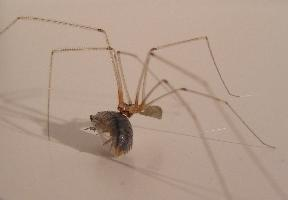
Animal description
The Cosmopolitan cellar spider, scientifically known as Pholcus phalangioides, is a species of spider that has garnered attention for its unique appearance and widespread distribution. This fascinating creature belongs to the family Pholcidae, commonly referred to as cellar spiders due to their preference for inhabiting dark and moist environments such as basements, garages, and caves.One of the most distinctive features of the Cosmopolitan cellar spider is its remarkably long and slender legs, which give it a delicate appearance and have led to its nickname, the "daddy long-legs spider." Despite this common name, it should not be confused with the harvestmen, which are arachnids but not true spiders. The body of Pholcus phalangioides is relatively small in comparison to its leg span, with adult body lengths typically ranging from 7 to 10 millimeters, while their leg span can reach up to 50 millimeters or more.
The coloration of these spiders is generally pale, varying from yellowish to light brown, with darker markings on the abdomen and cephalothorax. This subdued coloration allows them to blend into their surroundings, making them less conspicuous to both predators and prey.
Cosmopolitan cellar spiders exhibit fascinating behaviors, particularly in their hunting techniques. Unlike many spider species that rely on webs to capture prey, Pholcus phalangioides uses its webs more as a residence and a platform from which to launch attacks. They are known to be voracious predators, feeding on a variety of insects and even other spiders, including species much larger than themselves. They employ a strategy of vibrating their webs to ensnare prey or to intimidate potential predators, including humans, when disturbed.
Reproduction in Pholcus phalangioides involves the male performing a courtship display to attract a female. After mating, the female lays eggs, which she wraps in silk and carries in her mouthparts until they hatch. This maternal behavior ensures the survival of the next generation, protecting the eggs from potential threats.
The distribution of the Cosmopolitan cellar spider truly lives up to its name, as it can be found in various habitats around the world. Originally thought to be native to subtropical regions, this species has spread globally, largely due to human activity. Its adaptability and tolerance for a range of climates have allowed it to thrive in both natural and urban environments.
Despite their eerie appearance to some, Cosmopolitan cellar spiders are harmless to humans. They lack the venom potency to cause any significant harm, and their shy nature means they are more likely to flee than confront a human threat. In fact, having these spiders around can be beneficial as they help control the populations of pests and insects.
In summary, the Cosmopolitan cellar spider, Pholcus phalangioides, is a remarkable species known for its elongated legs, adaptability, and role as a natural pest controller. Its presence across various continents underscores its success as a species and highlights the intricate balance of ecosystems, where even the smallest creatures play a significant role.
New photos of animals
Top 10 animals
- Dolphin gull (Leucophaeus scoresbii)
- Diana monkey (Cercopithecus diana)
- Moustached guenon (Cercopithecus cephus)
- Galápagos tortoise (Geochelone nigra complex)
- Stone loach (Barbatula barbatula)
- Japanese macaque (Macaca fuscata)
- Russian tortoise (Testudo horsfieldii)
- Greek tortoise (Testudo graeca)
- Common flying dragon (Draco volans)
- Vendace (Coregonus albula)